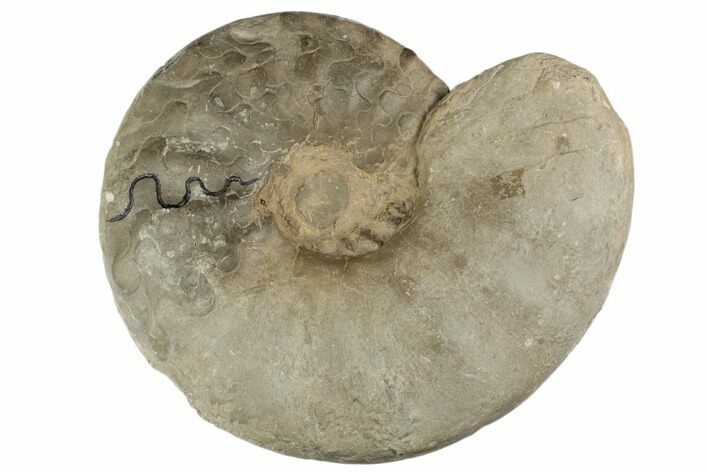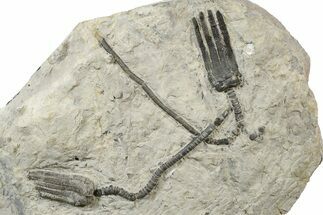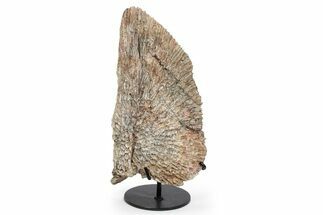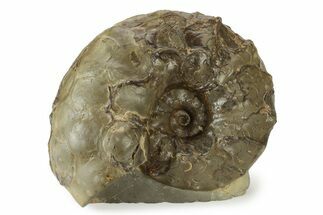This Specimen has been sold.
7.1" Triassic Ammonite (Ceratites) Fossil - Germany
This is an 7.1" wide specimen of a Middle Triassic ammonite (Ceratites sublaevigatus). It comes from the the Muschelkalk Formation in Germany.
Comes with a display stand.
Comes with a display stand.
About Ceratites
Ceratites is an extinct genus of ammonoid cephalopods that thrived during the Middle Triassic period, approximately 247 to 237 million years ago. It is one of the most recognizable genera from the order Ceratitida, a group that emerged following the end-Permian mass extinction and played a key role in the recovery of marine ecosystems.
Ceratites is easily identified by its typically discoidal, planispiral shell with ribbed or smooth flanks and a deeply indented suture pattern. Unlike the highly complex, fractal-like sutures of later ammonites, Ceratites features "ceratitic" sutures—characterized by rounded lobes and saw-toothed saddles. This suture pattern is a defining trait of the Ceratitida order and represents an intermediate complexity between the simpler goniatitic sutures of earlier ammonoids and the elaborate ammonitic sutures that evolved later.
Fossils of Ceratites have been found in marine sedimentary deposits across Europe, North Africa, and Asia, with especially well-preserved specimens discovered in Germany's Muschelkalk Formation. These ammonites inhabited shallow, warm epicontinental seas and are believed to have been active swimmers and predatory mollusks, likely feeding on smaller marine animals.
Ceratites is often used as an important index fossil for dating Middle Triassic rocks and provides valuable insights into the evolutionary transition and diversification of ammonoids following the Permian-Triassic extinction event.
Ceratites is an extinct genus of ammonoid cephalopods that thrived during the Middle Triassic period, approximately 247 to 237 million years ago. It is one of the most recognizable genera from the order Ceratitida, a group that emerged following the end-Permian mass extinction and played a key role in the recovery of marine ecosystems.
Ceratites is easily identified by its typically discoidal, planispiral shell with ribbed or smooth flanks and a deeply indented suture pattern. Unlike the highly complex, fractal-like sutures of later ammonites, Ceratites features "ceratitic" sutures—characterized by rounded lobes and saw-toothed saddles. This suture pattern is a defining trait of the Ceratitida order and represents an intermediate complexity between the simpler goniatitic sutures of earlier ammonoids and the elaborate ammonitic sutures that evolved later.
Fossils of Ceratites have been found in marine sedimentary deposits across Europe, North Africa, and Asia, with especially well-preserved specimens discovered in Germany's Muschelkalk Formation. These ammonites inhabited shallow, warm epicontinental seas and are believed to have been active swimmers and predatory mollusks, likely feeding on smaller marine animals.
Ceratites is often used as an important index fossil for dating Middle Triassic rocks and provides valuable insights into the evolutionary transition and diversification of ammonoids following the Permian-Triassic extinction event.
SPECIES
Ceratites sublaevigatus
LOCATION
Germany
FORMATION
Muschelkalk Formation
SIZE
7.1" across
CATEGORY
SUB CATEGORY
ITEM
#196059
We guarantee the authenticity of all of our specimens.
 Reviews
Reviews











